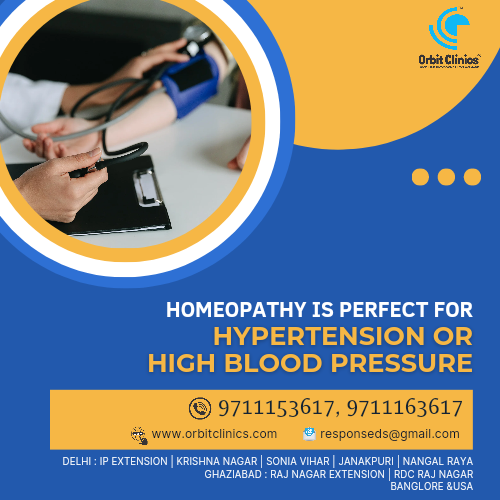A Comprehensive Guide to Healing Naturally

Written by
Dr. Deepak Sharma
BHMS, MD, Ph.D. (Scholar)
Homeopathic Physician and Educator
Founder – Orbit Clinics
Abstract:
This article provides a comprehensive overview of high blood pressure, or hypertension, including its etiology, risk factors, signs and symptoms, and pathogenesis. The etiology of hypertension is multifactorial, involving genetic and environmental factors. The article also explores the use of homeopathy as a holistic approach to managing hypertension, detailing common homeopathic remedies. Furthermore, it emphasizes the role of diet and exercise in managing high blood pressure, recommending strategies such as reducing sodium intake, increasing potassium consumption, engaging in aerobic exercise, and maintaining a consistent exercise routine. By combining homeopathic treatment with proper diet and exercise, individuals suffering from hypertension can potentially improve their overall health and manage their blood pressure more effectively.
Introduction:
High blood pressure, or hypertension, is a prevalent global health concern, affecting approximately one billion individuals worldwide. It is a significant risk factor for cardiovascular diseases, kidney disease, and stroke. Hypertension is often referred to as a “silent killer,” as it typically presents no symptoms until complications arise. This article will provide a comprehensive overview of high blood pressure, including its etiology, risk factors, signs and symptoms, and pathogenesis.
Etiology:
The etiology of hypertension is multifactorial, with various genetic and environmental factors contributing to its development. Hypertension can be classified into two main categories: primary (essential) hypertension and secondary hypertension.
- Primary Hypertension: This form of high blood pressure has no identifiable cause and accounts for about 90-95% of all cases. It is believed to result from a complex interaction of genetic, environmental, and lifestyle factors.
- Secondary Hypertension: This type accounts for 5-10% of hypertension cases and is caused by an underlying medical condition, such as kidney disease, hormonal disorders, or the use of certain medications. Treatment of the underlying cause usually resolves secondary hypertension.
Risk Factors:
Several risk factors are associated with the development of high blood pressure, including:
- Age: The risk of developing hypertension increases with age.
- Family History: Individuals with a family history of hypertension are more likely to develop the condition.
- Race: African Americans are more susceptible to hypertension than other racial groups.
- Obesity: Excess weight increases the risk of high blood pressure.
- Sedentary Lifestyle: A lack of physical activity contributes to the development of hypertension.
- Tobacco Use: Smoking or chewing tobacco can elevate blood pressure levels.
- Alcohol Consumption: Excessive alcohol intake can increase the risk of hypertension.
- High Salt Intake: Consuming large amounts of sodium can contribute to high blood pressure.
- Stress: Chronic stress may lead to hypertension, especially when accompanied by poor coping mechanisms.
Signs and Symptoms:
In most cases, hypertension does not exhibit any noticeable symptoms. However, some individuals may experience non-specific symptoms such as:
- Headaches
- Dizziness
- Blurred vision
- Shortness of breath
- Nosebleeds
It is essential to monitor blood pressure regularly, as early detection and intervention can prevent severe complications.
Pathogenesis:
The pathogenesis of hypertension is complex and involves various mechanisms that contribute to increased blood pressure. Some of the key factors include:
- Genetic Factors: Specific gene mutations or variations can predispose individuals to hypertension by affecting blood vessel function, hormone regulation, and kidney function.
- Renin-Angiotensin-Aldosterone System (RAAS): Overactivity of this system can lead to vasoconstriction, increased sodium retention, and fluid volume expansion, resulting in high blood pressure.
- Sympathetic Nervous System: Overactivity of the sympathetic nervous system can cause increased heart rate, vasoconstriction, and renal sodium retention, contributing to hypertension.
- Endothelial Dysfunction: Impaired endothelial function can lead to reduced production of vasodilators, such as nitric oxide, and increased production of vasoconstrictors, promoting hypertension.
- Insulin Resistance: Insulin resistance and hyperinsulinemia can contribute to hypertension by causing sodium retention, sympathetic nervous system activation, and vascular remodeling.
Homoeopathy: A Holistic Approach to Managing Hypertension
Homoeopathy is a system of medicine founded in the late 18th century by Dr. Samuel Hahnemann. It is based on the principle of “like cures like,” which means that a substance that can cause symptoms in a healthy person can cure similar symptoms in a sick person when administered in small, diluted doses.
Homoeopathic treatment for hypertension aims to address the root cause of the problem rather than merely controlling symptoms. It takes into account the individual’s physical, mental, and emotional state to develop a personalized remedy that stimulates the body’s innate healing capacity.
Common Homoeopathic Remedies for High Blood Pressure
- Rauwolfia serpentina: Also known as Indian snakeroot or sarpagandha, this plant has been used traditionally for treating hypertension. It has a calming effect on the nervous system and can help lower blood pressure.
- Nux vomica: Derived from the seeds of the poison nut tree, Nux vomica is useful for individuals with high blood pressure due to stress, anger, or overindulgence in food and alcohol.
- Glonoinum: Prepared from nitroglycerin, Glonoinum is prescribed for patients experiencing sudden, violent, and pulsating headaches or palpitations associated with high blood pressure.
- Baryta muriaticum: Derived from barium chloride, this remedy is beneficial for elderly patients with arteriosclerosis or hardening of the arteries.
- Lycopodium: Made from the spores of the club moss plant, Lycopodium is recommended for individuals with high blood pressure accompanied by digestive issues and a craving for sweets.
- Aurum metallicum: Prepared from gold, this remedy is suitable for people with hypertension related to emotional or mental stress, such as work pressure
The Role of Diet in Managing High Blood Pressure:
A well-balanced, nutritious diet plays a significant role in managing high blood pressure. Several dietary components have been found to affect blood pressure levels, including sodium, potassium, calcium, and magnesium. The DASH (Dietary Approaches to Stop Hypertension) diet, which emphasizes fruits, vegetables, whole grains, and lean proteins, has been shown to effectively lower blood pressure.
Dietary Strategies for High Blood Pressure Management
- Reduce Sodium Intake: Lowering sodium consumption can significantly reduce blood pressure levels. Aim for less than 2,300 mg of sodium per day, and consider even lower levels (1,500 mg) if you are over 50 or have additional risk factors.
- Increase Potassium Intake: Potassium helps counteract the effects of sodium on blood pressure. Consume potassium-rich foods such as leafy greens, bananas, oranges, potatoes, and yogurt.
- Consume Calcium and Magnesium: Adequate calcium and magnesium intake is important for maintaining healthy blood pressure. Dairy products, green leafy vegetables, nuts, seeds, and whole grains are good sources of these minerals.
- Focus on Whole Foods: Base your diet on whole, minimally processed foods, such as fruits, vegetables, whole grains, lean proteins, and healthy fats. Avoid processed and fast foods, which tend to be high in sodium, unhealthy fats, and added sugars.
- Limit Alcohol: Excessive alcohol consumption can raise blood pressure. Limit your intake to no more than one drink per day for women or two drinks per day for men.
Exercise Strategies for High Blood Pressure Management:
- Aerobic Exercise: Engage in at least 150 minutes of moderate-intensity aerobic exercise or 75 minutes of vigorous-intensity aerobic exercise per week. Activities such as brisk walking, swimming, cycling, and dancing can help lower blood pressure.
- Strength Training: Incorporate strength training exercises, such as weight lifting or resistance bands, at least two times per week to improve overall health and maintain muscle mass.
- Flexibility and Balance: Include stretching exercises and activities that promote balance, such as yoga and tai chi, to improve overall physical fitness and reduce the risk of falls and injuries.
- Gradual Progression: Increase the intensity and duration of your exercise program gradually to avoid injury and excessive fatigue.
- Consistency: Maintain a regular exercise schedule to promote long-term blood pressure control and overall cardiovascular health.
Conclusion:
High blood pressure is a pervasive global health issue that affects a significant portion of the population. The multifactorial nature of hypertension demands a comprehensive and holistic approach to its management. Homoeopathy provides a personalized treatment option that addresses the underlying causes of high blood pressure, complementing conventional medical interventions. Alongside homoeopathic remedies, adopting a healthy lifestyle, including a balanced diet and regular physical activity, plays a critical role in managing hypertension. By integrating these strategies, individuals can effectively control high blood pressure, reducing the risk of complications and promoting overall cardiovascular health. Ultimately, early detection, intervention, and a commitment to a healthier lifestyle are key in overcoming the challenges posed by hypertension.
References:
- Mills, K. T., Bundy, J. D., Kelly, T. N., Reed, J. E., Kearney, P. M., Reynolds, K., … & He, J. (2016). Global Disparities of Hypertension Prevalence and Control: A Systematic Analysis of Population-Based Studies from 90 Countries. Circulation, 134(6), 441-450.
- James, P. A., Oparil, S., Carter, B. L., Cushman, W. C., Dennison-Himmelfarb, C., Handler, J., … & Smith, S. C. (2014). 2014 evidence-based guideline for the management of high blood pressure in adults: report from the panel members appointed to the Eighth Joint National Committee (JNC 8). JAMA, 311(5), 507-520.
- Chobanian, A. V., Bakris, G. L., Black, H. R., Cushman, W. C., Green, L. A., Izzo Jr, J. L., … & Wright Jr, J. T. (2003). Seventh report of the Joint National Committee on Prevention, Detection, Evaluation, and Treatment of High Blood Pressure. Hypertension, 42(6), 1206-1252.
- Kearney, P. M., Whelton, M., Reynolds, K., Muntner, P., Whelton, P. K., & He, J. (2005). Global burden of hypertension: analysis of worldwide data. The Lancet, 365(9455), 217-223.
- Hahnemann, S. (2002). Organon of Medicine (6th ed.). B. Jain Publishers.
- Ullman, D. (2007). The Homeopathic Revolution: Why Famous People and Cultural Heroes Choose Homeopathy. North Atlantic Books.
- Sacks, F. M., Svetkey, L. P., Vollmer, W. M., Appel, L. J., Bray, G. A., Harsha, D., … & Karanja, N. (2001). Effects on blood pressure of reduced dietary sodium and the Dietary Approaches to Stop Hypertension (DASH) diet. New England Journal of Medicine, 344(1), 3-10.
- Pescatello, L. S., Franklin, B. A., Fagard, R., Farquhar, W. B., Kelley, G. A., & Ray, C. A. (2004). American College of Sports Medicine position stand. Exercise and hypertension. Medicine and Science in Sports and Exercise, 36(3), 533-553.



